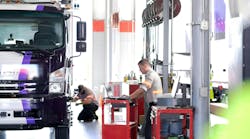Current fuel price surge differs from OPEC's heyday, as well as more recent episodes
When it comes to fuel prices, it seems that what goes down must come up again. This year's reversal has been quite sharp, as prices seemed to turn on - and by - a dime. But that's not unusual. What distinguishes this episode from other price spikes in the past decade is that it was not triggered by war, weather, or changes in taxes or regulations.
Instead, the price seemed to rebound from its three-year tumble based merely on a declaration by oil-producing countries that they would trim output. That sounds like a return to the bad old days of the 1970s, when the Organization of Petroleum Exporting Countries (OPEC) was able to dictate prices to the rest of the world.
In reality, there is both more and less going on than a bigger, badder, born-again OPEC cartel. First, the folks pledging these cutbacks control a smaller percentage of world output than OPEC did in the 1970s. More nations supply oil now than 20 years ago; many of those countries are eager to sell every drop they can pump.
Second, part of the price hop seen at the pump in recent months has nothing to do with cuts in crude oil production. It's a function of several refinery breakdowns in California. Because California has unique gasoline and diesel blends to meet the state's stringent clean-air rules, a hiccup in the supply chain there can quickly send prices soaring.
Third, a strong U.S. economy is keeping demand for petroleum products high. Even hints of a revival in Japan, plus extra demand from military operations in the Balkans, can be enough to pull up prices for both crude and products.
Fourth, a few states have begun to increase their fuel taxes. They're doing it to pay their way into the "TEA party" - the billions of dollars in matching grants that Congress promised to send under the Transportation Equity Act for the 21st Century, or TEA-21, to states that raise enough themselves.
Which of these factors is likely to have a lasting effect on fuel prices and which will fade away? The tax increases are clearly here for keeps; in fact, other states are sure to join the "party" in the next year or two. But these increases will only cause one-time jolts of a few cents here and there.
At the other end of the scale, the California problems will probably have reversed by the time you read this - unless a new set of misfortunes has erupted. California prices are likely to remain volatile in both directions for years to come.
The most important influence on product prices is how world supply and demand match up. Fortunately, producers have a very poor record of conspiring successfully to hold down output. Not only do current producers have every incentive to "cheat" on pledges to rein in production, but higher prices invariably lead to exploration and development of new and marginal fields. As for demand, so far a pickup has been slow to materialize. By the time Japan and other lagging economies do perk up, U.S. thirst for oil may finally be dropping.
The bottom line: Last year's fuel price plunge was a gift that companies can't expect to see repeated. But there's no cause for despair, either. The recent surge still leaves prices far below their levels of two years ago. In fact, some of the temporary factors may already be washing out. For the year as a whole, retail prices still appear likely to come in lower in 1999 than they did in 1998.


